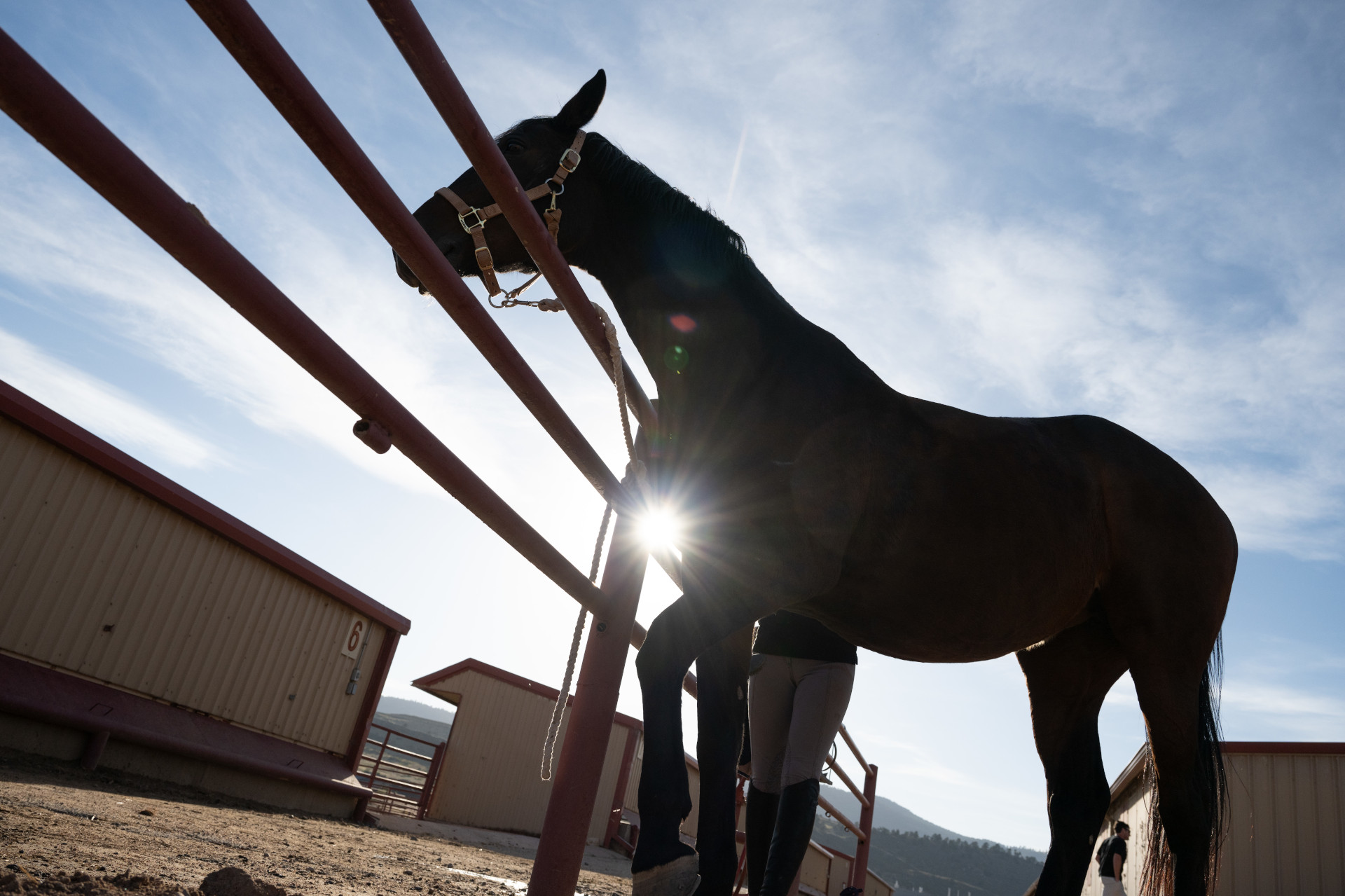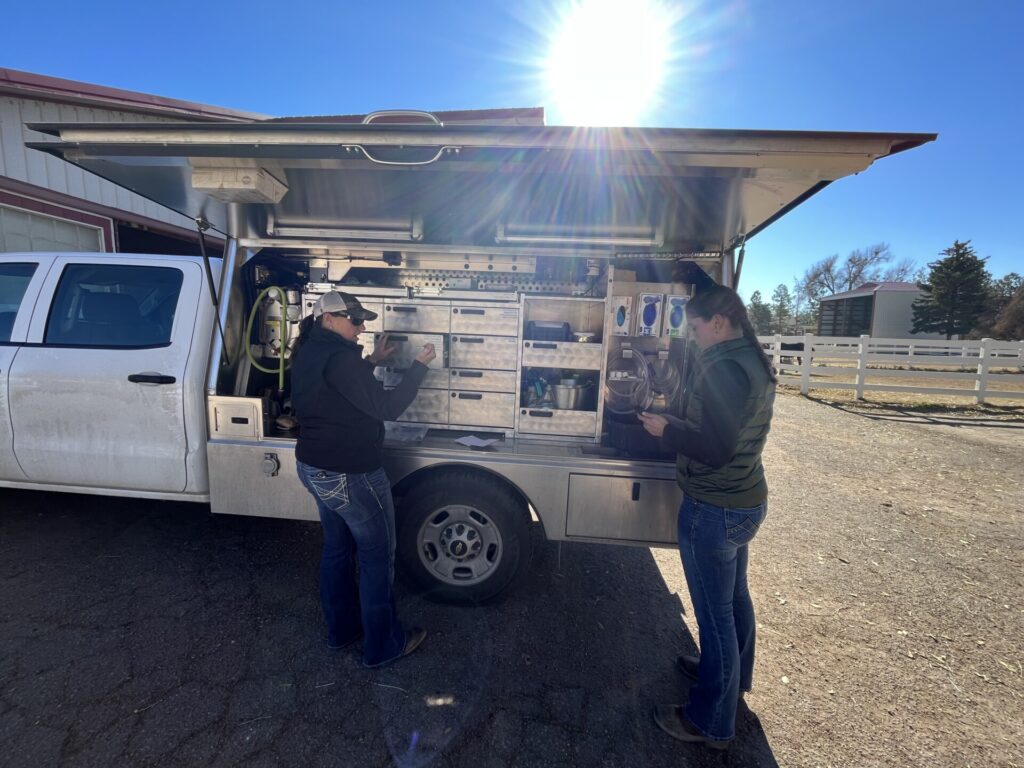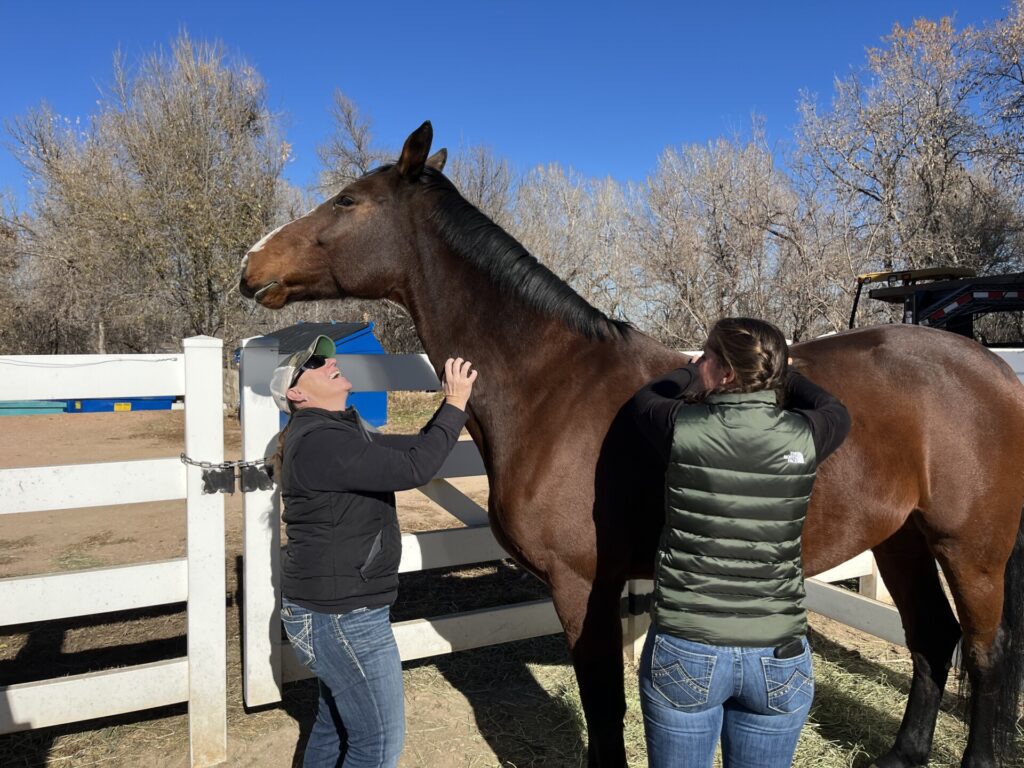
Out in the field
CSU’s Equine Field Service makes horse house calls along the northern Front Range
story by Christopher Outcalt
published Jan. 4, 2024
Standing inside a barn on a bright fall morning about 10 minutes from Colorado State University’s Johnson Family Equine Hospital, Dr. Anna Bracken pulled on a surgical glove, scooped a glob of medicated ointment onto her index finger and gently pressed it against the eye of a horse named Hunter.
Bracken swirled her finger around while looking for swelling or discoloration. Surprisingly, Hunter didn’t appear too bothered by it all. Bracken eventually plucked a tiny clump of dirt from behind Hunter’s eyelid and held it up on the tip of her finger, as if she’d just performed the final act of a magic trick.
“It’s just a little bit gooey,” Bracken said. “But the eye looks fine.”
After one more pass, Bracken was satisfied. Hunter’s eye was a little puffy, but it didn’t appear to be anything particularly concerning. Bracken recommended that Hunter’s owner, who’d been watching attentively nearby, apply some more of this ophthalmic ointment over the next few days to encourage any swelling to “quiet down,” and offered a few tips on how best to apply it.
“It looks like it just got a little irritated,” Bracken said.
Hunter was the second of three horses on the examination schedule that morning for the University’s Equine Field Service, a kind of family doctor on wheels for horses across the northern Front Range.
The service has been around as long as anyone can remember, at least several decades. During the past few years, though, it’s gotten much busier. Bracken estimates the caseload is about 150% of what it was five years ago. Emergency calls in particular have doubled.
“It’s really taken off,” she said.
Reliable and consistent
Bracken, a clinical sciences instructor, attributes some of the uptick in the caseload to an increasing shortage of equine veterinarians in private practice.
Only 1% of vet school grads go into equine practice, and within five years 50% of those veterinarians either transition to small-animal care or leave the profession altogether, according to the American Association of Equine Practitioners. The top reasons include burnout — the work can be physically and emotionally demanding — and lower starting salaries on average than in companion-animal practices.
To keep up with demand, the field service has been expanding its team. Bracken joined last spring, and the College of Veterinary Medicine and Biomedical Sciences is in the process of hiring a third faculty member. Two full-time interns staff the field service, up from one a few years ago. Fourth-year veterinary students also do regular field service rotations; it’s one of the most popular rotations CSU offers.
There is a particular need regionally for equine veterinarians who are willing to respond to emergencies. For that reason, the service has become a go-to for local emergency services, Bracken said. They’ve had calls about horses stuck in storm cellars or trapped in ponds. Earlier this year, the Fort Collins Police Department called in the middle of the night about a horse that had been hit by a car on Taft Hill Road and had a broken leg. “Fire and rescue need somebody,” Bracken said, “especially if they can’t identify the owner or who the regular vet is.”
More than just filling an ambulatory need, though, the field service staff has successfully built the program into a well-rounded and trusted resource for all kinds of equine care, said Dr. Luke Bass, an associate professor who first joined the field service in 2013. “I think it’s taking care of people — the animals and clients are treated with respect — and being reliable and consistent,” Bass said.
Similar to a family physician, the service performs basic medical procedures and regular checkups — everything from simple exams to dentistry and vaccinations. “We see anything and everything,” Bracken said. In October, the group performed nearly 1,500 procedures in a roughly 30-mile radius around CSU’s south campus.
What’s more, Bass said, the service has developed a good relationship with local practitioners. Recently, Bass responded to a call about a horse that was choking; the regular vet couldn’t make it and CSU was listed as the first referral. “We’re always available and do a good job,” Bass said. “But we’re not there to steal the case; that’s been really important from a professional relationship perspective.”

Outside and on the move
The quality of the field service has made the program successful with clients, but also as an educational tool for students, according to Dr. Kathryn Wotman, medical director of CSU’s equine clinical services.
“It gives our students the most realistic experience of what an equine practice is,” Wotman said. “Most of our students, if they go into equine practice, they’ll be in a truck; this gives them that real-world feel.”
The field service trucks are an essential component of the operation. The vehicles look similar to regular pickups with a kind of exam station built into the back. There are drawers full of medicine and medical instruments as well as portable x-ray and ultrasound devices. There are heaters and pop-up awnings that can provide shelter from sun or snow. The staff also make a point of keeping the truck stocked with plenty of horse cookies.
The morning Bracken was out examining Hunter’s eye, she was joined by Dr. Amanda Bowen, one of the service’s two full-time interns. After Bracken finished Hunter’s exam, Bowen made sure he got a treat. “I brought cookies to make up for poking you in the eyeball,” she said, patting him gently on his head.
Bowen had completed a successful rotation with the field service during vet school and knew she wanted to apply for an internship after graduating last year. She thought the position would be a good opportunity to continue to sharpen her veterinary skills. Just as important, though, she felt like she would fit in well with the group. “I love the team here,” Bowen said. “I don’t like being inside all day; I love being outdoors, going to people’s places.”
“It gives our students the most realistic experience of what an equine practice is. Most of our students, if they go into equine practice, they’ll be in a truck; this gives them that real-world feel.”
Kathryn Wotman, medical director of CSU’s equine clinical services

Prior to examining Hunter, Bowen had assisted with another horse, Thunder, at the same facility. Thunder was healing from an injury to one of his hind legs. The field service crew had brought along a shockwave machine that helps accelerate ligament recovery. Bowen took the lead on using the machine while Bracken watched and chatted with the horse’s owner about how Thunder had been feeling.
That comprehensive and personal touch is what many clients love about the field service. Jennifer Westlund moved to Colorado from Illinois in 2021 with her horse Rudy. Westlund was apprehensive about finding quality equine care in an unfamiliar place. That became an immediate issue one weekend last year when Rudy was showing signs of colic. Westlund contacted the field service, which showed up within the hour.
“The care I got was fantastic, and, thankfully, he pulled through just fine,” Westlund said. “I felt like my horse was important to them — and that was really reassuring, given the circumstances.”
Now, Westlund uses the field service and Dr. Bracken for Rudy’s more routine, regular care. Although Westlund could borrow one if needed, she doesn’t own a horse trailer, and so the field service coming to see Rudy at home is another perk. “I’ve just been really happy and satisfied with the field service,” she said. “Frankly, in many instances my horse has gotten better medical care than I have.”
Shared values
It’s not just horses and owners the field service staff care for — they also look after each other. The team operates like a family, Bass said, helping balance schedules and burnout. Developing those shared values has paid off. Despite the broader challenges within the profession, the last 10 interns who have worked with the field service are all still practicing in equine medicine.
“That’s pretty great,” Bass said. “I think a lot of that is because of the culture we’ve been able to foster.”
For Bracken, coming back to the field service was a dream job. It was her favorite rotation during vet school — one she signed up for multiple times. After graduation, she went into private practice in southern California. The scope of her work, though, was somewhat narrow, less exciting than a day out in the field service truck. When she learned there was an opening, it didn’t take long for her to decide to apply.
“You’re not trapped somewhere; you get to actually be out in the world and feel the sunshine,” Bracken said. “You get to see the horses in their home environment, where they’re healthy and happy. I love it.”